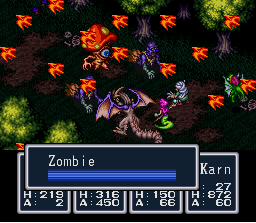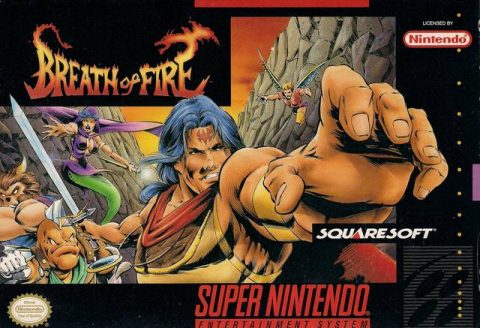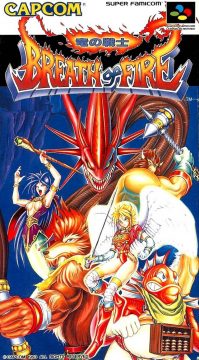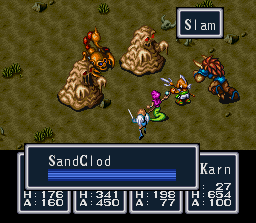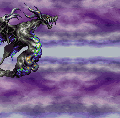Breath of Fire is, for the most part, a forgotten relic from the rise of the RPG. It garnered a cult fandom in the 16-bit era and then slowly slid off into obscurity as Squaresoft crushed all of its competition. And it’s really sad, because the Breath of Fire series – Capcom’s flagship title in the realm of RPGs – is really something else.
With the exception of the radical Breath of Fire: Dragon Quarter for the PlayStation 2, the gameplay in Breath of Fireis your standard JRPG. One of the big draws are the anthropomorphic character designs – the range spans from dogs to cats to rabbits and even plants. Most important are the two recurring characters – the dragon boy Ryu and the winged angel-like girl Nina. Although each game is its own contained story (with a loose plot connecting most of them together), every one of them stars a reincarnation of Ryu and Nina.
With the advent of 16-bit consoles, RPGs really began to take off in Japan and began to garner cult support in the western world. Sadly, this cult status meant that Western fans wouldn’t get most of the RPGs that came out on those systems. One of the few that came through the rift of translation was Breath of Fire. The first Breath of Fire game wasn’t a vast improvement over the already established RPG formula, and its story was nowhere near as developed as that of Final Fantasy IV, which had already aged considerably by then. It did, however, establish a flavor all of its own that would be carried over for the entire series to some extent, and some very enjoyable gameplay elements.
Breath of Fire takes place during the waning years of a great civil war between the White Dragons and the Black Dragons. The White Dragons are dwindling, and their last hope rests in a young boy named Ryu, who sets out on an adventure to save his people. Along the way, he meets many colorful companions, who have undergone some drastic name changes due to the 4-character text limitation for menu entries, but some of it is just plain bad translation. Indeed, Breath of Fire‘s strongest point is its characters. They are far more interesting than their counterparts in more typical Final Fantasy-style RPGs, and each has their own unique skill they can use either on the world map or in battle.
Characters
Ryu
The main hero of the game. He’s mute, spunky, a bit rugged, and has all the qualities of your average RPG hero, aside from the not so common ability to morph into a dragon. He can also fish. Fishing for actual fish isn’t rewarding at all, but when used in certain secret spots, his ability nabs him some of the best items in the game.
Nina
The first companion Ryu meets. A young, winged princess who’s introduced in quite an original fashion. Instead of simply joining the party, the story actually diverts from the hero’s quest for quite a while and centers on Nina’s mission to save her father from illness. The player follows her without really knowing who she is, and when she runs into trouble, the player must retrace her steps as Ryu and rescue her. Later on, she becomes a crucial element to the story and gains the ability to turn into a giant bird.
Bo / Gilliam
Bo (Gilliam in Japan) is a wolf person from a small village in the west. After Ryu helps him save his village, he joins the party. Other than that, he remains rather quiet. His initial bit of backstory is all the backstory you’ll ever get for him. While on the overworld map, Bo can “hunt” by firing arrows at wild animals. He’s not very good at this and frankly, it’s quite useless even if you get the hang of it. In battle, however, he’s one of the better characters throughout the game, learning a host of useful magic and boasting the highest amount of HP until Ox comes along.
Karn / Danc
Karn is a thief the party meets while heading through some less-than-savory criminal territory. You need his lockpicking skills to get through certain areas in the game, meaning he’s going to be in the party quite a bit. Aside from being pretty fast, he later on gains the ability to fuse himself to Bo, Ox, and Gobi, transforming into various hideous, but extremely powerful mutant creatures, making him one of the best characters in the game.
Gobi / Manillo
Gobi is a fish man, identical to all those merchants met along the quest. He allows the party to travel underwater to the city where all of the fish merchants originate. This is one of the cooler and more original parts of the game. Gobi is pretty useless in battle, but thanks to his money-grubbing, fast-talking demeanor, he’s a really likable character. A bit later he can transform into a giant fish, enabling him to reach all sorts of new areas.
Ox / Builder
Ox is the big, tough, muscle-bound guy that every RPG seems to have, and as his name implies, he looks like a cross between a man and an ox. Like almost every character in the game, he has an issue, and when Ryu helps him resolve it, he joins the party. Ox’s crucial skill is his ability to smash through cracked walls by punching them. It can also be used to knock fruit out of trees, something that’s required to trigger a certain story event much later on in the game. In battle, he’s got tons of HP and does heavy damage, but he’s rather slow.
Bleu / Deis
Bleu is an amusing character. Aside from having the upper torso of a busty woman and the lower torso of a snake, she’s some sort of all-powerful deity (later on revealed to be a Goddess in Breath of Fire III). However, she’s also complete slacker and a pervert. Her status as Goddess is implied with her magic selection, consisting of the most powerful magic in the game. Unlike all the other characters, she has no unique skill.
Mogu
Like Nina, the final member of the party is introduced in a very original way. Before you even know who this mole-man is, you must travel inside of his mind and rid his subconcious of his own fears and demons by litterally killing them. Afterwards, he joins your party, and then all kinds of neat stuff happens. Mogu’s ability to burrow into certain patches of dirt is one of the most rewarding abilities in the game. If you have a good enough memory to recall where you’ve encountered strange symbols on the ground throughout the world map, you can find some of the most powerful weapons and spells in the entire game underneath.
Despite this incredible cast of characters, playing Breath of Fire isn’t always fun. What really drags the game down is the battle system. There’s no variety at all, and it’s very traditional. The odds are always stacked against you as well. It seems every little minor battle in a new area or dungeon requires massive amounts of recovery spells and items afterwards. Since you have a limited number of spaces in your inventory, it’s not uncommon to have your supplies nearly exhausted by the time you reach the boss of a long dungeon. And the dungeons in Breath of Fire are LONG. The boss battles in the game can also be a bit frustrating. They’re not so much hard (many bosses are less dangerous than the lackeys who inhabit their lairs) as they are extremely well protected. They seem to live forever. It’s almost depressing to watch their health meter deplete at barely noticable rates. Even when they die, they’re not dead. They inexplicably regain their composure after they lose all their HP and stick around for a few more rounds before they finally depart from this world. In addition, many bosses have the ability to heal themselves.
The true fun of Breath of Fire lies outside of the battles. The dungeons in this game are huge. Not content to merely be places where enemy encounters occur as Final Fantasy‘s are, the dungeons in Breath of Fire are complex labyrinths full of traps, puzzles, and all sorts of treasures. Some of the puzzles in this game will inspire nostalgic feelings of playing Zelda. Also, as you venture through the dungeons of Breath of Fire, you may notice areas that can’t be reached. You may see an unattainable treasure chest behind a cracked wall or a locked door. If you remember these locations later on when you meet new characters with abilities that can overcome those obstacles, you can backtrack and get yourself some amazing items. This adds a whole new level of depth to RPG dungeon crawling previously unseen. If it weren’t for all the random encounters, dungeon crawling in this game would be an adventure all on its own.
Outside of the huge dungeons is an even larger world map, one of the largest for that era. Once again, Breath of Fire goes beyond the simple Final Fantasy aproach and adds a level of interactivity with the world map that hadn’t really been seen in those days. The world map in Breath of Fire isn’t just a flat, scrolling surface where your gargantuan character stomps around and enters towns merely the size of his face. It has wildlife, varied terrain, dozens of secrets, and even a night and day engine that has a real-time effect on the activity of monsters and NPCs in towns.
In the visual and audio departments, Breath of Fire stands up fairly well. The graphics are decent. At their worst, they’re a bit too colorful. It is, however, one of the earlier SNES RPGs that had fully animated enemies, and the characters in battle were proportionate in comparison to most RPGs where they remain super deformed in almost every instance. Breath of Fire sports a pretty catchy soundtrack of synthesized orchestral tunes with a heavy emphasis on flute, a bit reminiscent of the Ghosts ‘n Goblin games. The best of these is a particularly haunting piece that usually plays in forests. The two later world map themes are also very nice.
Capcom, who developed the first Breath of Fire for Super Famicom in 1993, had never attempted to translate a game with dialogue of this density before, and even their attempts at translating games with very little dialogue had infamously poor results. Not only this, but Capcom had already begun work on Breath of Fire II. So, they decided to have Square, already known for the most massive dialogue translation at that time, bring the game over to US audiences. Despite Square working on the title, Breath of Fire still wasn’t translated very well. Square obviously didn’t put much effort into it, and understandably so, as development of their next big Final Fantasy title was already well under way. Breath of Firedidn’t make it to US store shelves until 1994, making it even less impressive now that huge games like Secret of Manaand Final Fantasy III (AKA VI) were making a name for themselves. However, RPGs were still few and far between in America, so gamers jumped at every opportunity to experience them. This made Breath of Fire a cult hit in America, ensuring that it would not be a one-trick pony.
Overall, Breath of Fire is a pretty good RPG, but it’s more recommended to a fans of Zelda than a fan of Final Fantasy, because the emphasis clearly isn’t on story. It is, however, just the beginning of a great series of RPGs. It’s there to set the groundwork and for the most part, nothing more.
In 2001, Capcom decided to port their cult RPG hit to Nintendo’s powerful little handheld shortly after it was released. Sadly, it doesn’t seem that Capcom utilized that power too well. It’s very much the same game, with the only visual improvement being some spiffy new artwork and character portraits displayed during dialogue. Unfortunately, they didn’t bother to retranslate any of the text, so the writing is still pretty lame. However, the gold and experience gained after battle has been increased, so the game’s a bit less difficult. As with most SNES-to-GBA ports, the soundtrack in Breath of Fire suffers dramatically, as it now sounds scratchy and muffled.
Cameos, References, Easter Eggs and other Nonsense
Street Fighter II – Yes, the kenpo-using, street-fighting babe Chun Li makes an infamous cameo appearance in Breath of Fire. This takes place in the Town of Thieves. There’s a small house in the corner of the town where a man will ask you if you want to see something cool. If you say yes, you’ll peep through and see Chun Li practicing her Hanretsu Kyaku.
Ghosts ‘n Goblins – If you look closely at all the portraits hanging on the walls of houses in this game, you’ll see that they are in fact of Arthur, the heart-patterned boxer shorts-wearing hero of the Ghosts ‘n Goblins games. It actually seems to be the face of his sprite from Super Ghouls ‘n Ghosts.
Mega Man V – One of the bosses, Goda, has an uncanny resemblance to Stone Man from Mega Man V. It’s not simply that they’re both made of similar brick-pattern stone, but he even has the very distinct Wilybot style eyes that all Wilybots have.
George Romero – Earlier in the game, there is a town called Romero. Considering that if you go to the town during the evening, there are zombies all over the place, it’s quite obvious that this is a reference to George Romero, director of legendary zombie thrillers such as Night of the Living Dead, Dawn of the Dead, and many others. This is the same in both the English and Japanese versions – apparently, one of the staff members was a fan.
Screenshot Comparisons

